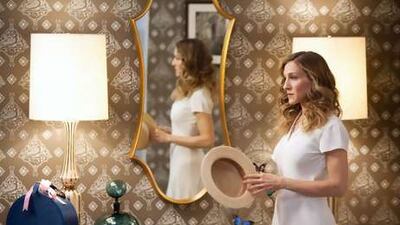Never mind the fashion and the Morocco-based "Abu Dhabi" locations ... it's the interiors or, more specifically, Carrie and Big's new Fifth Avenue apartment that I want to clock, in the new SATC film. How Carrie has interpreted their status as a couple through the apartment's decor will be a fascinating piece of design anthropology. From what I've seen online, the result is a grown-up pad, such as you would expect from the suited and booted Big, with splashes of typical Carrie eccentricity. The living room is dominated by a bold velvet sofa and a coffee table - which is, in fact, a huge tray, that is deep enough to accommodate books displayed vertically. Nifty. I love the quirky blue tiling (from a distance, it looks like the sea) in the fabulously mid-century style kitchen. Their bedroom is more classical, with damask wallpaper (by Cole & Son) and the Hallings Secretary (used as a desk-cum-television stand) - a piece that is lusted over by interior designers for its slanted proportions and chic pale exterior - dark interior contrast. But the scene stealer is bound to be Carrie's wardrobe - she is sharing now - so it's a dark wood finish for him and bright white for her. Says it all, really.
The finishing touches are being given to London's most expensive, recession-snubbing residential development, One Hyde Park (which the UK's Royal Mail postal service refuses to recognise, insisting it is 100 Knightsbridge). Developed by Candy & Candy (who are currently suing Qatari Diar for £81 million for breach of contract over another project), these guys have built their reputation on providing an ultra-slick, gadget-laden aesthetic: think Rollerball meets 007. The first to introduce biometric reading (fingerprint-recognition) door locks into the UK, Nick Candy once memorably commented: "If you're running your own bath and drawing your own curtains, you're living in the past." The company's innovation team has developed new technology for One Hyde Park, including TVs that recede into the walls, to be replaced by mirrors or pictures; refrigerated ceilings to eliminate the annoying whirr of air conditioning (why haven't developers thought of having that here?) and a mirror in the walk-in wardrobes that films you as you rotate in front of it, and then plays a close-up of your back view. Er, in the Land of Denial, I'm happy to forgo that one.
With its pantheon of design classics, by such greats as Mies van der Rohe, Eero Saarinen and Warren Platner, Knoll is a renowned victim of copycats. So to launch its new London HQ, the furniture company staged The Fakes Debate. Such a hot potato was guaranteed to pack out the showroom. The crux of the matter is that with today's fickle market constantly demanding novelty, and innovation seen as high risk, copying is an easier path. And at the click of a mouse, you have instant reach. But to have an inventive society, we need originals and the rewards of making it. Design must be protected, so that the incentive for creatives remains. "You can't copy something you don't fundamentally understand," explained the great Ross Lovegrove, who pointed out how architects went wrong attempting to imitate the maxim of Le Corbusier. "They should copy the knowledge, not the object," said Abraham Thomas, the curator of design at the V&A Museum. "When things mutate they lose their spirit," Lovegrove continued. "When I look at the copy of my Moroso chair ... it's like looking at an old friend who's had plastic surgery." The conclusion? Now is the time to take risks.
Egypt has beaten the UAE in establishing the region's first design festival with +20 Egypt Design. Organised in collaboration with Design Partners (who are behind the successful Zona Tortona event in Milan), it coincides with the country's furniture trade show, Furnex (now until June 7). Located in Cairo's renovated Old Town the district's shops, mosques and museums make a special backdrop for the event, which comprises a series of installations in three town houses, curated by the Italian designer Paola Navone and a products showcase, featuring some of the best Egyptian design companies alongside international brands. Since the establishment of the London Design Festival in 2003, design festivals have been popping up in cities around the world as governments cotton on to the fact that design and creativity can boost business - particularly vital in today's economic climate, when the financial industry has so badly scuppered things.
Yvonne Courtney is a design writer and consultant, and the co-founder of online magazine designtastic

